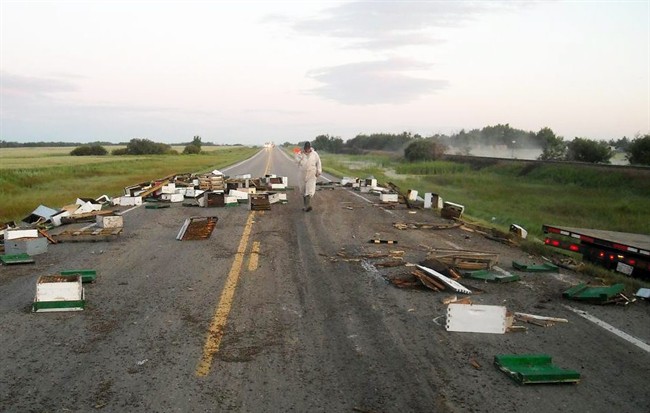CAMROSE, Alta. – It was a traffic accident with an added sting.

RCMP officers had to close an Alberta highway Thursday morning after a truck carrying honey bees rolled into the ditch.
Mounties say the contents of 104 hives spilled onto both sides of the two-lane road near Camrose southeast of Edmonton.
Police issued an advisory for drivers to be on the lookout for the insects that may have been left somewhat incensed after the collision.
“I would not recommend anybody get too close because the bees are going to be agitated. They’re going to be somewhat scared, disoriented and so on,” said Tony Rafaat with the Alberta Beekeeping Commission. “There’s probably a greater likelihood of being stung.”

Get daily National news
Police say the accident happened when one of the truck’s wheels dropped over the highway’s shoulder into the ditch. The flatbed rolled onto its side and skidded several hundred metres when the driver overcorrected in his attempt to get the wheel back on the road.
The owner of the bees arrived on the scene and advised the fire department to spray a mixture of water and foam. RCMP say that killed a lot of the buzzers and brought the situation down to a “manageable level.”
The owner also arranged for several of his workers to help clean up. The surviving hives where loaded into two separate vehicles and taken back to their home. The highway was then reopened.
A caller to CHED radio station in Edmonton said he witnessed the accident, but it was still dark and he didn’t realize the flatbed truck was carrying bees.
But he did notice some stinging sensations.
“I had not as many as the RCMP officer on site,” said the caller named Chad. “I think I took maybe 15, 20 hits, but you don’t think about it with the adrenaline pumping.”
The truck driver was taken to a local hospital where he was checked out and released.
Rafaat suggested any surviving bees were unlikely to have flown very far because they would want to reunite with their queen and the rest of the colony.
But he added that people shouldn’t get a bee in their bonnet about any of the wayward nectar collectors.
The escapees are European honey bees, which aren’t nearly as aggressive as potentially deadly African honey bees which are known to pursue, swarm and sting.
(CHED, The Canadian Press)








Comments